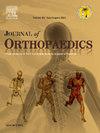Robotic-assistance did not reduce complications in total hip arthroplasty
IF 1.5
Q3 ORTHOPEDICS
引用次数: 0
Abstract
Aims & objectives
Robotic-assisted total hip arthroplasty (rTHA) is an increasingly common method of joint arthroplasty used to improve surgical accuracy and reduce human error. Despite not having compelling clinical data on long-term complications or outcomes to justify additional time costs, its rate of use is increasing. In this study we compare the longitudinal rates of complications between patients undergoing conventional total hip arthroplasty (cTHA) and rTHA.
Materials & methods
Data from the TriNetX Research Network identified subjects with at least 5 years of patient follow up data through electronic health records. The first cohort were patients undergoing cTHA, and the second cohort included patients undergoing rTHA. Propensity score matching of known factors that can affect clinical outcomes at 1:1 ratio was performed to reduce confounding variables. Records with conditions unrelated to primary THA such as pathological fracture or revision arthroplasty were excluded. Rates of complication in five outcomes were observed at 1, 3 and 5 years: prosthetic joint infection, dislocation, revision, loosening, and periprosthetic fracture.
Results
The database contained 95,085 THA patients. Analysis was performed with 2241 patients in each matched cohort. At 5 years, there was no difference in all-cause complications between the cTHA cohort and rTHA cohort [OR (95 % CI), 1.073 (0.772–1.491)]. Also, no differences were noted in rates of revision [OR (95 % CI), 1.1.604(0.726, 3.543)] or dislocation [OR (95 % CI), 1.775(0.976, 3.228)].
Conclusion
Despite evidence for improved surgical accuracy and reduced errors, robotic assistance did not reduce the rate of complications over a 5-year period after total hip arthroplasty.
机器人辅助并没有减少全髋关节置换术的并发症
的目标是,目的机器人辅助全髋关节置换术(rTHA)是一种越来越普遍的关节置换术方法,用于提高手术精度和减少人为错误。尽管没有关于长期并发症或结果的令人信服的临床数据来证明额外的时间成本是合理的,但其使用率正在增加。在这项研究中,我们比较了接受常规全髋关节置换术(cTHA)和rTHA患者的纵向并发症发生率。材料,方法来自TriNetX研究网络的数据通过电子健康记录确定了具有至少5年患者随访数据的受试者。第一组为接受cTHA的患者,第二组为接受rTHA的患者。对可能影响临床结果的已知因素按1:1的比例进行倾向评分匹配,以减少混杂变量。排除与原发性THA无关的记录,如病理性骨折或翻修关节置换术。在1年、3年和5年观察5种结果的并发症发生率:假体关节感染、脱位、翻修、松动和假体周围骨折。结果数据库共纳入THA患者95085例。对每个匹配队列的2241例患者进行分析。5年时,cTHA组和rTHA组的全因并发症无差异[OR (95% CI), 1.073(0.772-1.491)]。此外,在翻修率[OR (95% CI), 1.1.604(0.726, 3.543)]或脱位率[OR (95% CI), 1.775(0.976, 3.228)]方面也没有差异。结论:尽管有证据表明机器人辅助提高了手术准确性并减少了错误,但在全髋关节置换术后的5年期间,机器人辅助并没有降低并发症的发生率。
本文章由计算机程序翻译,如有差异,请以英文原文为准。
求助全文
约1分钟内获得全文
求助全文
来源期刊

Journal of orthopaedics
ORTHOPEDICS-
CiteScore
3.50
自引率
6.70%
发文量
202
审稿时长
56 days
期刊介绍:
Journal of Orthopaedics aims to be a leading journal in orthopaedics and contribute towards the improvement of quality of orthopedic health care. The journal publishes original research work and review articles related to different aspects of orthopaedics including Arthroplasty, Arthroscopy, Sports Medicine, Trauma, Spine and Spinal deformities, Pediatric orthopaedics, limb reconstruction procedures, hand surgery, and orthopaedic oncology. It also publishes articles on continuing education, health-related information, case reports and letters to the editor. It is requested to note that the journal has an international readership and all submissions should be aimed at specifying something about the setting in which the work was conducted. Authors must also provide any specific reasons for the research and also provide an elaborate description of the results.
 求助内容:
求助内容: 应助结果提醒方式:
应助结果提醒方式:


